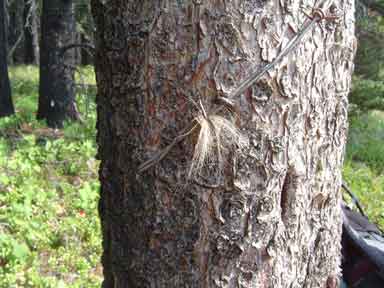Bears don't rub trees because their backs are itchy. Dr Owen Nevin of the University of Cumbria states that adult male grizzly bears use so-called “rub trees” as a way to communicate with each other while looking for breeding females, and that this behavior could help reduce battles between the bears.
Many theories have been advanced as to why bears rub trees: some thought females might rub trees as they came into oestrous, and others that bears might be giving their backs a good scratch to get rid of parasites or pick up sap to act as insect repellent. Until now these ideas have been extremely difficult to test because bears usually live at low densities and rubbing is relatively rare behavior.

Because bears use the same rub trees for generations, and because he has logged rub trees over almost a decade working on bears in British Columbia in Canada, Nevin has been able to gain a unique insight into grizzlies' behaviour. Over the past two years, he used four digital cameras with infra-red trips set up opposite rub trees to collect data on which bears used the trees and when. He coupled this with satellite telemetry equipment to track individual bears' movements.
“The cameras show that adult male bears are the most likely to rub trees, and the satellite telemetry tells us that males move from valley to valley in large loops, marking trees as they go, while looking for breeding females,” Nevin says.
Nevin believes that by marking trees, adult males may be getting to know each other better, and that this scent familiarity could act as a way of reducing fighting among adult male bears. According to Nevin: “Big male bears can seriously injure and even kill each other when they get into a fight. If one recognises the other from the scent marks on the rub trees in the area he knows he’s in for a tough fight - he’s on the other guy’s patch so to speak - so it might be better to back away than make a serious challenge.”
Like other species, male bears will sometimes kill a female’s offspring to get a chance to mate with her; scientists refer to this as sexually-selected infanticide. Nevin’s work suggests that very young bears may be using the rub trees to help them trick potentially killer males. “It’s really hard to document, but on several occasions the cameras caught cubs who are being chased away from their mother by a large male visiting and rubbing on trees which he has marked. They can visit the tree two or three times in a day, sometimes within an hour of the big male, so it may be that smelling like him makes them safer – related animals smell similar and animals are less aggressive towards relatives,” Nevin says.
As well as improving our understanding of how bears communicate, the results should also help improve bear conservation by affording an insight into the behaviour of secretive male bears. Earlier work in Canada and Alaska has shown that tourist activities can change how adult male bears behave during the autumn salmon-feeding season, which has been the focus of eco-tourism, but spring viewing when the bears are breeding is becoming increasingly popular.
According to Nevin: “Understanding normal behaviour has to be the starting point for managing bear populations and our activities around them. It doesn’t matter whether we’re considering impacts of tourism or sport hunting on these dense North American populations or reintroductions and enhancements in threatened European populations: knowing how these animals interact with each other will help us to make the right decisions.”
Source: British Ecological Society





Comments